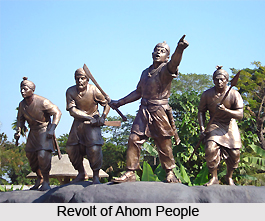 Political disturbances during Sulikphaa`s rule commenced after the assassination of Laluk Rajmantri Phukan for his atrocities. Although Sulikphaa was the Ahom ruler, the real power always lied in the hands of his Prime Minister Laluk Rajmantri Phukan. The latter was notorious for his atrocities over the kingdom and was assassinated through a conspiracy by Bhotai Deka along with his colleague Madha Tamuli, belonging to Nagaon, who was about to be victimized in the mutilation campaign of Laluk Rajmantri Phukan. After his demise, Bhotai Deka and Madha Tamuli earned great appreciations for freeing the kingdom from the atrocities and sinister influence of Laluk. They both were unanimously declared as saviours and patriots. These appreciations encouraged the two leaders to rule over the stately affairs without any opposition. They established their headquarters at the residence of Laluk Rajmantri Phukan which had all the equipments of a fortified garrison. However the supporters of Sulikphaa did not comply with the scenario and they marched inside the palace along with the forces to encounter Bhotai and Madha.
Political disturbances during Sulikphaa`s rule commenced after the assassination of Laluk Rajmantri Phukan for his atrocities. Although Sulikphaa was the Ahom ruler, the real power always lied in the hands of his Prime Minister Laluk Rajmantri Phukan. The latter was notorious for his atrocities over the kingdom and was assassinated through a conspiracy by Bhotai Deka along with his colleague Madha Tamuli, belonging to Nagaon, who was about to be victimized in the mutilation campaign of Laluk Rajmantri Phukan. After his demise, Bhotai Deka and Madha Tamuli earned great appreciations for freeing the kingdom from the atrocities and sinister influence of Laluk. They both were unanimously declared as saviours and patriots. These appreciations encouraged the two leaders to rule over the stately affairs without any opposition. They established their headquarters at the residence of Laluk Rajmantri Phukan which had all the equipments of a fortified garrison. However the supporters of Sulikphaa did not comply with the scenario and they marched inside the palace along with the forces to encounter Bhotai and Madha.
Entrapment of Non-Ahom Rulers
During this phase, the two leaders were appointing officers as per their wish. These actions were against the Ahom monarch but the two leaders could not be harmed as they had become the idols of the people. Thus the supporters of Sulikphaa tried to deal with the situation with consideration and tact. Two envoys Ananta Kataki and Madhabcharan Kataki were thus sent by the Phukans of the monarch for asking Bhotai and Madha to arrive to the palace and offer their submission to the king. Firstly the invitation was refused by Bhotai Deka on suspicion of a trap for him and his supporters. However later, owing to much persuasion from his officers who had received threats to be slaughtered, Bhotai accepted the invitation. For escorting Bhotai Deka and his supporters to the palace, Gargayan Sandikoi Phukan was sent by the king. On approaching the palace they were all arrested and were asked for submission to get freedom. On acting as per the orders, Bhotai Deka Saikia and Madha Tamuli were set free and were sent home. Marangi Borbarua, who was also arrested along with the two leaders, then begged for his freedom and was freed after clipping his ears.
Mutilation of Bhotai Deka
As per the order of the king, Bhotai Deka proceeded towards his home Nagaon, leaving his kingdom. While he was sailing down to Kaliabar, Hulou Deka-Phukan saw his boat and ordered the boatman to bring his boat towards his barge. The Phukan then warned the king about not allowing Bhotai to be free in full bodily fitness. Thus with the consent of the monarch the nose and ears of Bhotai were cut off and one of his eyes was plucked before returning to Nagaon.
Escape of Sulikphaa
When the younger brother of Bhotai Deka, Bhatdhara, learnt about these events he fled to Kaliabar to seek refuge under the Mughal rule in Guwahati. During this phase he was positioned as Borphukan at Kaliabar. In Guwahati he requested for military assistance from Mughal Subedar of Bengal but was refused as the Mughal army in this region was not enough to battle against the Ahom. On receiving the information about Bhatdhara`s fight, Sulikphaa appointed Bandar Lanmakharu Chetia for the post of Borphukan at Kaliabar. Owing to all these chaos Sulikphaa was advised by his ministers to shift his residence to Garhgaon form Meteka.



















